I had my holiday close-call, and my most trying experience as a boat owner yet, on Christmas eve. I just took the boat out to warm up the engine so I could do an oil change and winterization. 100 feet off the buoy, I slipped it into reverse and heard a very loud BANG--I thought I’d blown out reverse gear. Forward worked okay, and I was already off the buoy, so I continued my half-lap around the bay to warm up the engine. A few hundred yards further, I took a peek under the cockpit bench to glance at the engine and saw water pouring into the boat (ounces per second, not gallons, but still a steady flow).
I motored back to the buoy, tied up and investigated below. Water was still below the floorboards, but above the automatic Rule 800 pump. I flipped on the panel-operated pump (a Rule 500) and was able to pump down to the bottom of the bilge, which gave me time to investigate.
The loud bang must have been the sound of the PSS shaft seal rupturing, as I could see a 1-1 ½” split in the bellows allowing water to rush in. The best fix I could think of was trash bags, so folded one into a 4” strip, wrapped, and then zip-tied it around the around the back of the PSS. This just made the water flow out the front of the bag, but two or three wraps later, with a couple of bilge pump cycles in between, and I was no longer worried about imminent sinking of the boat.
I called a neighbor, gave him my Boat US number, and had him call towing/insurance for me while I worked the leak. Once the the leak seemed stable, I rowed back into the dock for more supplies. My neighbors brought me heavy-duty trash bags (for more wraps), an AC sump-pump and hose for extra pumping capacity, and a gas can to refill the generator. By about this time, TOW/BOAT US called back with the good and bad news. Good--they could get to me in 60-90 minutes. Bad—where were they going to tow me at 4 pm on Christmas Eve?? We discussed ideas and the unlikely-hood that any haul-outs would be available before Monday, 12/28. The TOW/BOAT US guys were great, and offered to do whatever I felt best, but we agreed the best thing to do was to stay put where it is easy for me to keep tabs on the boat. TOW/BOAT US checked back with me at least once a day throughout the ordeal to offer further assistance.
Thus began the 4-1/2 day saga of keeping the boat afloat, the short-story of which involved:
- all day/night checks on the boat every 90 min to 4 hours, depending on the changing situation
- four underwater wet-suit dives to try to pack around the hull and prop shaft (I used plumber’s putty on the first two dives, then Teflon pipe thread sealer, then an all-weather sealant called Lexel). None stopped the leaked, but the second dive with putty was probably the most successful.
- a quick trip to a local marine shop when stores opened on Saturday, to pick up a second bilge pump switch. Originally, I had one auto-switched and one manually operated pump. I purchased a Water Witch 230 so I would two fully automatic pump systems (one primary and one set higher as a backup). When I went install it, in a sure sign the gods were against me, the pump was defective! And, in the process, of messing with the boat, I inadvertently rotated the prop shaft which made the leak worse. By this time, the boat store had closed for the day. This was the longest and most sleepless night of checking on the boat.
- on Sunday morning, I sent my son out to Lowes to pick up an AC sump pump switch. The AC pump my neighbor loaned me was small enough to fit into the bilge—it just needed a switch to make it automatic. I would run the generator 24 hours/day to keep AC power on the boat with the sump pump & switch as primary and my switched Rule 800 as secondary.
- Along the way, I had my first bit of really good news. On Saturday, another neighbor friend who is a retired fishing boat captain called in a favor with the Gig Harbor Marina lift operator. Gig Harbor was going to resume normal operations on Jan 4th, but my neighbor was able to talk the lift operator to coming in on Monday morning (12/28) to haul me out.
- After getting AC and DC pumps set up, I went back to 4 hour shifts of checking on the boat. My last check was at midnight on Monday morning. I was back out at the boat at 330am to get it prepped for the TOW/BOAT US crew who would be arriving at 5am. We towed from 5am to 8am to arrive at the GH marina for haul out at 9am. I was exhausted, but the boat was safe—water never got up to floorboard level.
Anyone who has a PSS probably knows that they don’t just go exploding or violently rupturing open on their own, like mine seemed to. Actually, the depth transducer cable had been run through the PVC bilge drain pipe that runs underneath the engine pan. After exiting the pipe, it laid loosely at the bottom of the hull, just a few inches blow the prop shaft. Something I had done over the last few months must have caused this cable to push upward into a loop that caught on the shaft coupling and wrapped the cable tight around the bellows when I shifted into reverse. The tightened cable split the bellows open and was then ripped in two by the turning shaft.
Boat is now on the hard in Gig Harbor. Gieco/Boat US is sending a surveyor out to look at in on Monday.
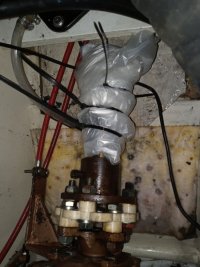 PSS after the first several wraps with trash bags and zip-ties.
PSS after the first several wraps with trash bags and zip-ties.
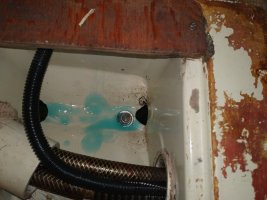 The small but steady leak (cutting through blue bilge cleaner) after I wrapped, dove, and tried plugging from the outside. I kept pouring in bilge cleaner to cut down on the oily residue that was collecting on the bilges, pumps, and hoses.
The small but steady leak (cutting through blue bilge cleaner) after I wrapped, dove, and tried plugging from the outside. I kept pouring in bilge cleaner to cut down on the oily residue that was collecting on the bilges, pumps, and hoses.
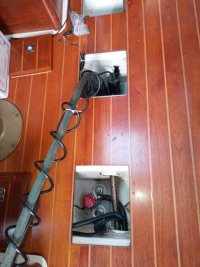 AC and DC bilge pump setup.
AC and DC bilge pump setup.
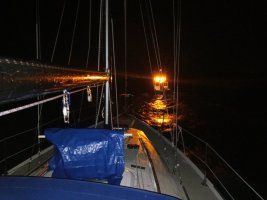 5am tow to the Harbor. Generator is wrapped in a tarp on the cabin top.
5am tow to the Harbor. Generator is wrapped in a tarp on the cabin top.
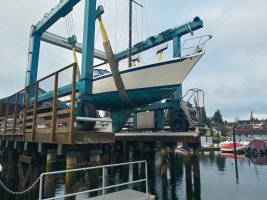 Safe at last.
Safe at last.
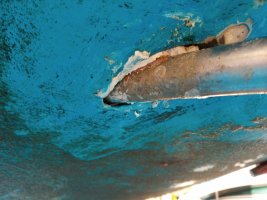 Some of the material I tried to pack around the shaft during dives.
Some of the material I tried to pack around the shaft during dives.
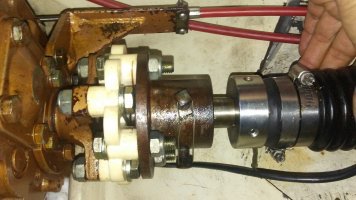 An old 2017 photo showing where the depth transducer cable was routed when I got the boat.
An old 2017 photo showing where the depth transducer cable was routed when I got the boat.
I motored back to the buoy, tied up and investigated below. Water was still below the floorboards, but above the automatic Rule 800 pump. I flipped on the panel-operated pump (a Rule 500) and was able to pump down to the bottom of the bilge, which gave me time to investigate.
The loud bang must have been the sound of the PSS shaft seal rupturing, as I could see a 1-1 ½” split in the bellows allowing water to rush in. The best fix I could think of was trash bags, so folded one into a 4” strip, wrapped, and then zip-tied it around the around the back of the PSS. This just made the water flow out the front of the bag, but two or three wraps later, with a couple of bilge pump cycles in between, and I was no longer worried about imminent sinking of the boat.
I called a neighbor, gave him my Boat US number, and had him call towing/insurance for me while I worked the leak. Once the the leak seemed stable, I rowed back into the dock for more supplies. My neighbors brought me heavy-duty trash bags (for more wraps), an AC sump-pump and hose for extra pumping capacity, and a gas can to refill the generator. By about this time, TOW/BOAT US called back with the good and bad news. Good--they could get to me in 60-90 minutes. Bad—where were they going to tow me at 4 pm on Christmas Eve?? We discussed ideas and the unlikely-hood that any haul-outs would be available before Monday, 12/28. The TOW/BOAT US guys were great, and offered to do whatever I felt best, but we agreed the best thing to do was to stay put where it is easy for me to keep tabs on the boat. TOW/BOAT US checked back with me at least once a day throughout the ordeal to offer further assistance.
Thus began the 4-1/2 day saga of keeping the boat afloat, the short-story of which involved:
- all day/night checks on the boat every 90 min to 4 hours, depending on the changing situation
- four underwater wet-suit dives to try to pack around the hull and prop shaft (I used plumber’s putty on the first two dives, then Teflon pipe thread sealer, then an all-weather sealant called Lexel). None stopped the leaked, but the second dive with putty was probably the most successful.
- a quick trip to a local marine shop when stores opened on Saturday, to pick up a second bilge pump switch. Originally, I had one auto-switched and one manually operated pump. I purchased a Water Witch 230 so I would two fully automatic pump systems (one primary and one set higher as a backup). When I went install it, in a sure sign the gods were against me, the pump was defective! And, in the process, of messing with the boat, I inadvertently rotated the prop shaft which made the leak worse. By this time, the boat store had closed for the day. This was the longest and most sleepless night of checking on the boat.
- on Sunday morning, I sent my son out to Lowes to pick up an AC sump pump switch. The AC pump my neighbor loaned me was small enough to fit into the bilge—it just needed a switch to make it automatic. I would run the generator 24 hours/day to keep AC power on the boat with the sump pump & switch as primary and my switched Rule 800 as secondary.
- Along the way, I had my first bit of really good news. On Saturday, another neighbor friend who is a retired fishing boat captain called in a favor with the Gig Harbor Marina lift operator. Gig Harbor was going to resume normal operations on Jan 4th, but my neighbor was able to talk the lift operator to coming in on Monday morning (12/28) to haul me out.
- After getting AC and DC pumps set up, I went back to 4 hour shifts of checking on the boat. My last check was at midnight on Monday morning. I was back out at the boat at 330am to get it prepped for the TOW/BOAT US crew who would be arriving at 5am. We towed from 5am to 8am to arrive at the GH marina for haul out at 9am. I was exhausted, but the boat was safe—water never got up to floorboard level.
Anyone who has a PSS probably knows that they don’t just go exploding or violently rupturing open on their own, like mine seemed to. Actually, the depth transducer cable had been run through the PVC bilge drain pipe that runs underneath the engine pan. After exiting the pipe, it laid loosely at the bottom of the hull, just a few inches blow the prop shaft. Something I had done over the last few months must have caused this cable to push upward into a loop that caught on the shaft coupling and wrapped the cable tight around the bellows when I shifted into reverse. The tightened cable split the bellows open and was then ripped in two by the turning shaft.
Boat is now on the hard in Gig Harbor. Gieco/Boat US is sending a surveyor out to look at in on Monday.
 PSS after the first several wraps with trash bags and zip-ties.
PSS after the first several wraps with trash bags and zip-ties. The small but steady leak (cutting through blue bilge cleaner) after I wrapped, dove, and tried plugging from the outside. I kept pouring in bilge cleaner to cut down on the oily residue that was collecting on the bilges, pumps, and hoses.
The small but steady leak (cutting through blue bilge cleaner) after I wrapped, dove, and tried plugging from the outside. I kept pouring in bilge cleaner to cut down on the oily residue that was collecting on the bilges, pumps, and hoses. AC and DC bilge pump setup.
AC and DC bilge pump setup. 5am tow to the Harbor. Generator is wrapped in a tarp on the cabin top.
5am tow to the Harbor. Generator is wrapped in a tarp on the cabin top. Safe at last.
Safe at last. Some of the material I tried to pack around the shaft during dives.
Some of the material I tried to pack around the shaft during dives. An old 2017 photo showing where the depth transducer cable was routed when I got the boat.
An old 2017 photo showing where the depth transducer cable was routed when I got the boat.